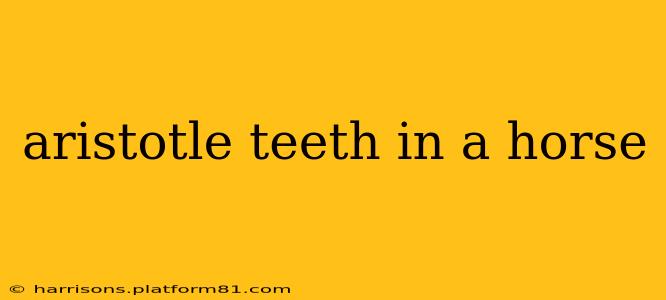The phrase "Aristotle's teeth in a horse" might sound like a riddle or a whimsical expression, but it actually points to a fascinating intersection of history, veterinary science, and the enduring legacy of the ancient Greek philosopher, Aristotle. While Aristotle didn't personally examine equine dentition in a way that would leave behind "teeth," the expression highlights a common misconception surrounding horse teeth and their age. Let's delve into the intriguing world of equine dentistry and explore the truth behind this curious phrase.
What Does "Aristotle's Teeth in a Horse" Actually Mean?
The expression doesn't refer to any literal teeth belonging to Aristotle found in a horse's mouth! Instead, it's a metaphorical way of describing the difficulty in accurately determining a horse's age solely by examining its teeth. Aristotle, renowned for his extensive observations of the natural world, might have studied horses, but precise methods for age determination using teeth weren't established until centuries later.
Today, veterinarians use equine dentistry to assess a horse's age, but it’s not an exact science. While the eruption and wear patterns of a horse's teeth provide valuable clues, numerous factors can influence their development, including breed, nutrition, and general health. This variability explains why accurately pinpointing a horse's age through its teeth alone can be challenging—hence the metaphorical reference to "Aristotle's teeth," suggesting an element of uncertainty or complexity.
How Do Veterinarians Determine a Horse's Age Using Teeth?
Veterinarians utilize several key features of a horse's teeth to estimate its age:
- Eruption Patterns: Certain teeth emerge at specific ages, providing a general timeframe. For example, the appearance of permanent incisors follows a predictable sequence.
- Wear Patterns: The degree of wear on the incisors' surfaces, particularly the angle and shape of the cups (the infundibulum), changes over time.
- Shape and Angle of the Incisors: As a horse ages, the angle of its incisors changes, and the shape of the biting surface alters.
- Dental Star: The "dental star" is a dark area that appears at the center of the wearing surface of the incisors and gradually increases in size with age.
However, factors like diet, grinding habits, and even dental abnormalities can affect the rate of wear and eruption, leading to variations.
Can You Accurately Determine a Horse's Age Based Solely on Teeth?
No, determining a horse's age solely based on its teeth isn't completely accurate. While tooth examination provides a strong indication of approximate age, it's not a precise method. Other factors need to be considered for a more accurate age estimation.
What other factors influence a horse's apparent age based on teeth?
- Breed: Different breeds of horses may have varying tooth eruption and wear patterns.
- Nutrition: A horse's diet significantly influences the rate of tooth wear. A horse on a diet rich in abrasive materials may show faster wear than a horse on a softer diet.
- Genetics: Genetic predisposition can affect tooth development and growth rate.
- Dental Health: Dental problems, like periodontal disease or malocclusion, can accelerate wear or alter the normal tooth development, skewing age estimations.
- Management Practices: Horses that are frequently used for grinding tasks may have a faster rate of wear.
Why is Accurate Age Determination Important for Horses?
Accurate age assessment is crucial for various reasons:
- Assessing Fitness for Work: The age of a horse influences its suitability for different activities, especially in competitive events.
- Appropriate Management: Knowing a horse's age helps in tailoring its management practices, including nutrition, exercise, and healthcare.
- Breeding Decisions: Age is a critical factor in reproductive decisions for breeding horses.
- Insurance and Valuation: A horse's age directly impacts its value and insurance premiums.
In conclusion, while the expression "Aristotle's teeth in a horse" is a playful reminder of the complexities involved, equine dentistry remains a valuable tool in estimating a horse's age. However, it's crucial to remember that multiple factors can influence the accuracy of the assessment, necessitating a holistic approach involving other indicators. The phrase serves as a testament to the enduring challenges and nuances inherent in studying the equine world, even with the advanced techniques available today.
